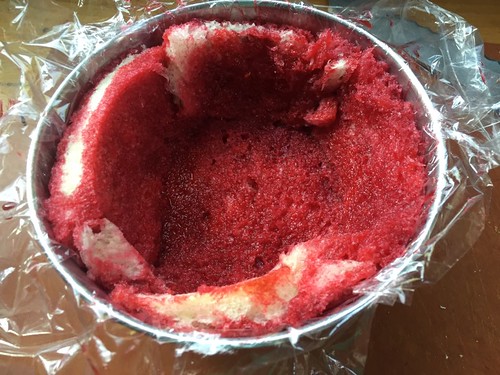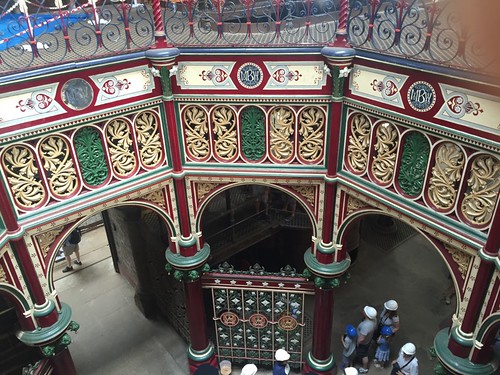It’s been too long since we talked about food, but recently a few things came together to correct that. The first thing was this:
The second thing that led me to the inevitable was an email exchange with a local English friend in which I semi-bragged about having a particularly “Swallows and Amazons” day that started with picking said blackberries on the towpath and then proceeded to a very agreeable spell of moving the boat in the bright sunshine.
(Aside for Astute-but-non-UK-based Go Stay Work Play Readers: "Swallows and Amazons" is a series of young adult novels, an accompanying 1960s tv series, and two feature films about the four siblings of the Walker family who have grand adventures in the Lake District involving sailing, camping, fishing and piracy. It's all a health and safety nightmare that would never fly today. However, in the Swallows world, the Walker dad - a naval officer absent on duty in Malta - remotely gives the children permission for a particularly dangerous nighttime sailing mission with an oft-quoted telegram reading, "BETTER DROWNED THAN DUFFERS IF NOT DUFFERS WON'T DROWN", an utterly un-modern message, but indicative of the sort of Empire-building, Blitz-surviving qualities that make some over here go all misty-eyed. "Swallows and Amazons" is English and summery and nostalgia-for-a-time-now-lost.)
So my email about blackberries and boating led to this response:
I reviewed several recipes online before settling on one from the BBC website as a guide, but being genetically incapable of following a recipe to the letter, I free-styled it a bit, partly because I wasn’t going to make anything like the volume of pudding the recipe called for, and partly because I didn’t feel like doing a lot of measuring, and partly because of the aforementioned inherited propensity to muck about with recipes. For instance, it seemed utterly boring to cook the fruit in water. In a stroke of genius I can only describe as utterly inspired, I elected to use Pimm’s as my stewing liquid, reasoning that a bit of booziness would only add to the party, and what says English summer more than Pimm's?
The recipe on which I based my summer pudding is here, but I sense it’s the kind of thing you can muck about with infinitely, so I’ll just outline what I did and pretend it's a proper recipe. The amounts suggested here are from the BBC and are for a 1.25 litre pudding basin which seems to be about 17cm (or size 30, for those fluent in the arcane field of pudding basin sizing). I do own a proper pudding basin, but it's massive (size 18 maybe?) and since I was not making summer pudding for the entire England Test Cricket side, I used a non-traditionally shaped metal bowl of about half a litre. Not really tall enough for a properly shaped pudding, but it yielded four small though adequate portions.
While chilling, something sort of magical happens as the juice soaks in all over and everything gets pressed together. When you turn it out onto a plate the next day the whole thing holds together remarkably well. Maybe it’s the pectin in the fruit? Whatever the cause, my pudding was decidedly flatter than most pictures you see if you Google for images of summer pudding but still, I think, still turned out quite credible.
The big question, of course, is how did it taste? Short answer: great! The bread was surprisingly not soggy - ending up with a texture that was more like very very moist cake. The berry flavour was huge and yummy and sweet and tart and perfectly summery. And a pour of double cream over the top turned it into a luxurious treat to have with a cup of coffee on a sunny afternoon.
Happily, this recipe is super easy to make and doesn’t include anything that’s difficult to find in Not-The-UK (like Marmite or golden syrup or red telephone boxes), so I urge you all try it out. It’s summer in a bowl. And if you wanted to swap out the coffee for a glass of Pimm’s, we here at Go Stay Work Play Live World Headquarters would heartily endorse that variation.
The towpath where I’ve had the boat moored in the last few weeks features a good collection of wild blackberry bushes. (Actually it turns out the towpath is a veritable supermarket, as pointed out by an oddly friendly and garrulous woman who was passing the boat one day as I was leaving and showed me where the hazelnut trees were and talked about growing up picking all kinds of produce on the towpath, including crabapples and other things I can’t remember because I was slightly unnerved by how she absolutely glommed onto me to relate this information.)
(Aside for Astute-but-non-UK-based Go Stay Work Play Readers: "Swallows and Amazons" is a series of young adult novels, an accompanying 1960s tv series, and two feature films about the four siblings of the Walker family who have grand adventures in the Lake District involving sailing, camping, fishing and piracy. It's all a health and safety nightmare that would never fly today. However, in the Swallows world, the Walker dad - a naval officer absent on duty in Malta - remotely gives the children permission for a particularly dangerous nighttime sailing mission with an oft-quoted telegram reading, "BETTER DROWNED THAN DUFFERS IF NOT DUFFERS WON'T DROWN", an utterly un-modern message, but indicative of the sort of Empire-building, Blitz-surviving qualities that make some over here go all misty-eyed. "Swallows and Amazons" is English and summery and nostalgia-for-a-time-now-lost.)
So my email about blackberries and boating led to this response:
A bit of explanation is probably needed here, for the above mentioned AbnUKbGSWPLRs. First, a reminder about pudding."Fresh blackberries, how fantastic. The start of a summer pudding ;-)"
Summer pudding falls into this category, though it’s not actually cooked at all. But it is a sweet end-of-meal treat and it is prepared in a pudding basin (or not, as we shall see). It’s a cold dessert made with stale bread and soft summer fruits, usually raspberries, red currants, and blackberries, but can also include strawberries, blueberries and other fringe fruit like black or white currants, loganberries and tayberries (which I'm pretty sure are made up). (Also note that the currants listed here are the fresh variety, not the dried fake-inferior-raisin thing you might be thinking of.)"In one sense, "pudding" refers to the entire panoply of sweet stuff you might have at the end of a meal. In fact, the course called dessert is often called pudding here, which I find just charming. As in, "What's for pudding, mum?” Sadly, the term pudding is slowly being supplanted by "dessert", which I also find kind of sad. It's like hearing "fries" instead of "chips" or "cookies" instead of "biscuits" and feels like the last small tumble in the fall of the Empire. More specifically, "pudding" can refer to a whole family of cakey sort of things that are cooked by steam, and can include both sweet and savoury options. Christmas pudding is probably the best known pudding out there, but other favourites include the most excellent Sticky Toffee Pudding, and the giggle-inducing Spotted Dick."
I reviewed several recipes online before settling on one from the BBC website as a guide, but being genetically incapable of following a recipe to the letter, I free-styled it a bit, partly because I wasn’t going to make anything like the volume of pudding the recipe called for, and partly because I didn’t feel like doing a lot of measuring, and partly because of the aforementioned inherited propensity to muck about with recipes. For instance, it seemed utterly boring to cook the fruit in water. In a stroke of genius I can only describe as utterly inspired, I elected to use Pimm’s as my stewing liquid, reasoning that a bit of booziness would only add to the party, and what says English summer more than Pimm's?
The recipe on which I based my summer pudding is here, but I sense it’s the kind of thing you can muck about with infinitely, so I’ll just outline what I did and pretend it's a proper recipe. The amounts suggested here are from the BBC and are for a 1.25 litre pudding basin which seems to be about 17cm (or size 30, for those fluent in the arcane field of pudding basin sizing). I do own a proper pudding basin, but it's massive (size 18 maybe?) and since I was not making summer pudding for the entire England Test Cricket side, I used a non-traditionally shaped metal bowl of about half a litre. Not really tall enough for a properly shaped pudding, but it yielded four small though adequate portions.
Towpath Summer Pudding:
Ingredients:- 7-ish slices of strong white bread, about 1 cm / 1/2" thick. (Enough to completely line your bowl, including a lid.) Staleness is a bonus.
This should not be that plastic kind of mass-produced pre-sliced white bread that basically melts when confronted with liquids of any kind. And no whole grains. Now is not the time for overly healthy sanctimoniousness. Some recipes recommend brioche, which would probably be really nice.
- 1.25kg / 2 lbs of mixed raspberries, blackberries, fresh currants, strawberries, tayberries, loganberries, whateverberries… (Enough to fill your bowl. It seems to be traditional to go heavy on the raspberries.)
- 175 grams / 3/4 cup white sugar (caster sugar for UK readers)
- 3 tbsp Pimm’s (or water, but really?) I found I needed more juice, so be generous.
- Cream, for serving. Ideally, double cream.
- Pudding basin or deep bowl. Straight-ish sides is nice.
- A lid or plate or flat circular thing that fits inside the top of the bowl
- Small heavy thing that can sit on the lid/plate/circular thing
- Saucepan and spoon
- Sieve or colander (Or, if you live on a boat and don't have a colander, the upside down lid of an Ikea cheese grater.)
- Clingfilm (Saran wrap)
- Wash the fruit and dry on a paper towel (piece of kitchen roll). Slice the strawberries.
Rasperries and blackberries, washed and waiting
- In a saucepan, melt the sugar and liquid together and then add the fruit (except the strawberries, if you’re using strawberries)
- Bring to a boil to extract the juices from the fruit, but don’t cook so long that the fruit starts to break down.
- Strain the juice into a bowl and reserve the fruit for later.
- Meanwhile, cut the crusts off the bread slices and shape them so they can completely line the bowl. Cut a circular bit for the bottom of the bowl, or fit two pieces together to cover the bottom, and then use slices or fingers to completely fill in the sides. Also cut a piece or pieces for the top. Dry fit these all and then set them aside. (Aside: I’m guessing this might be the first recorded use of the term “dry fit” in a culinary context…)
Line the bowl with a big piece or pieces of clingfilm (saran wrap) - enough to completely cover the sides and fold up over the top. This will make it easier to de-mould the pudding later.
- Dip the bottom bread piece(s) quickly into the fruit juice on both sides so they get soaked, and put the bread into the bowl. Continue dipping the side pieces and placing them until the whole inside of the bowl is covered. Use small scraps to fill in spaces and overlap if needed.
It really doesn’t matter if it looks a bit raggedy.
- Fill the bread-lined bowl with the cooked fruit, dotting in slices of uncooked strawberry if you’re using strawberries.
- Drizzle in any remaining juice. (I didn’t do it, but I sense this would be an excellent time to put in another splash of Pimm’s. I remain haunted by that lost opportunity.)
- Cover with the top bit(s) of bread and fold the clingfilm over the top to cover it all.
- Put the plate or lid or flat circular thing on top of it all and then put the small heavy thing on top of that to press everything down. (A tin of something from the cupboard seems to be traditional.)
Chill the pudding in the fridge for at least 6 hours, though overnight is better.
The completed pudding, already missing a piece. Fantastic colour!
Yum.






















